The Federal Highway was empty save for a few cars. This was the second time we were chasing the sunrise, and today, our destination was Jugra. There was not much we knew about Jugra beforehand. Only that it was not widely publicised, and was a former Royal seat of the Selangor Sultanate. Not exactly a best-kept secret but neither had it reached commercial heights so often associated with tourism efforts.
We drove from Kuala Lumpur into Klang, and slowly, skyscrapers turned into suburbia and eventually, long stretches of wilderness with the occasional neighbourhood. The drive westwards too, was a visual journey of socioeconomic difference. As we drove further away from the metropolis, past Klang city centre and into smaller non-descript neighbourhoods – the tarmac became increasingly dangerous to drive on. Random potholes dotted the rest of the drive, due to wear and tear of both the elements and industrious logistics.
As we exited the main road from Klang and into narrow networks, we slowly drove in the network of villages. Lanes small enough to accommodate a single car, and maybe two motorcycles coming from opposing directions. But it was 5 am. There was no life but us and the rumblings of the car engine. It wasn’t until 5.30 am did we arrive what we believed to be the foot of Bukit Jugra.
“Let’s see if we can get a good sunrise vantage point,” I suggested. I could sense a reluctance in both Asyraf and Adi, both who are more cautious when it comes to risk-taking. But with the promise of an adventure, Asyraf, who was on driving duty this morning, slowly ascended the hillside. We drove in the winding road, the light of the car leading our way.
Then, I saw it. The side of the hill was barely visible but the moonlight just about made it visible. We were driving alongside a hillside graveyard. I said nothing, not wanting to alarm Asyraf and read the Al-Kursi under my breath. Asyraf, thank goodness, did not notice. His attention was dedicated to the winding road ahead. We arrived at the peak without incident – parking ourselves at the Bukit Jugra Lighthouse. We did not leave the car and neither of us wanted to.
However, we paused for a few minutes, admiring the lighthouse’s beam of light that cut across the night sky. But we could not stay here for long. So, with tension, Asyraf reversed and made way downhill – uncomfortable with the darkness of the hilltop. As he drove down speedily but carefully, I prayed he did not notice the graveyard. After all, it was too dark to notice if your sole focus was the road ahead.
We arrived at the foothill and I quickly said, “You do know that we-“.
Adi stopped me. “Let’s talk about this later”. Ah, so he noticed it too.
We weren’t out of the woods yet. The foot of Bukit Jugra was quiet, dark and we still had an hour and a half before sunrise was due. Asyraf suggested a McDonald’s but there was none in these parts. So we made our way south, grasping in the dark. No less than fifteen minutes later, in nervous chatter, did we arrive Pantai Kelanang. The beachfront (or what resembled it) was deserted but lighted. We stopped there, noticing another car on the way into the parking lot.
Asyraf switched off the car engine. Adi and I started trading our observations from earlier.
“Dude, we were driving past a cemetery”, I said.
“I didn’t want to say anything but yeah”, Adi concurred.
Asyraf groaned. “I knew it. I should have checked this place out before we went. I didn’t have the time”. Asyraf, if it wasn’t clear by now, was not fond of the supernatural. We went out of the car, and Asyraf lighted a cigarette and took long drags – likely trying to shake off the earlier tension of possibly encountering other-worldly entities.
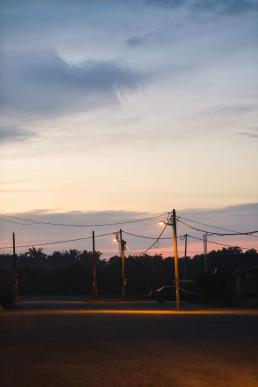
It was only around 6.30 am did we finally make our way back to Bukit Jugra. Instead of the hill, we opted to drop by a fishing village we passed by along the way, Sungai Kelanang. It was a small but charming stretch of river with fishing boats dotting the jetty. We parked ourselves and immersed in the scent of the sea. Slowly, the morning light bathed the small boats.

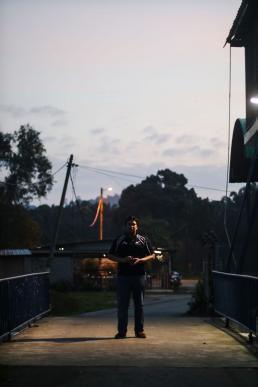

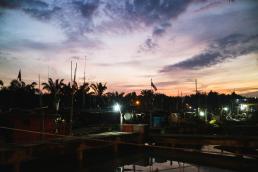

The sun was rapidly ascending, and life was pouring into the small river stretch. Old men and burly middle-aged men rode in with motorcycles. The nearby fresh fish market, a small modest one, opened its two sole stores. A group of children, with fishing rods in their hands, clambered to the riverside. A gang of buffalos climbed out of the river they were resting in and moved into the plantations.
To be perfectly honest, while the sunrise was nothing spectacular, it was the atmosphere of an awakened community that gave charm to this small little section of the state.
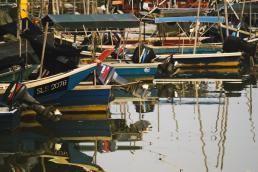
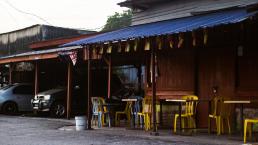
Once the sun was a little above the horizon, we had breakfast at a nearby stall in the village. The fare was simple: an offering of fried Kuey Teow, Nasi Goreng Kampung, sambal, fried egg and peanuts. When it was done, we readied ourselves to return to Bukit Jugra. It was already morning, the sun was up and we were unlikely to encounter the supernatural. So we drove back.
By the time we arrived the foot of Bukit Jugra, we saw lines of cars parked along the narrow road. Groups of people were in exercise attire and a convoy of bicycles passed by us. All were heading uphill.
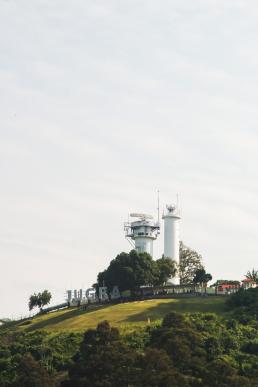
So, a little bit of cultural history: Colonial Portugese maps mark Bukit Jugra as Mont Parcelar, or Parcelar Hill. British philologist Walter William Skeat wrote of the legends associated with the hill. Through inquiry, he describes the hill as being populated by ghost tigers, pets of Puteri Gunung Ledang.
The story runs that this estimable lady [Puteri Gunung Ledang], having disposed of her husband by pricking him to death with needles, decided thenceforth to live free from the restrictions of married life. She was thus able to visit distant lands, taking with her a cat of fabulous dimensions as her sole attendant. This cat appears to have been a most amiable and accommodating creature, for on arriving at Jugra he carried the Princess on his back to the top of the hill. Here the lady remained for some time, and during her stay constructed a bathing-place for herself. Even to this day she pays periodical visits to Jugra Hill, and although she herself is invisible to mortal eye, her faithful attendant, in the shape of a handsome tiger [rimau keramat], is often to be met with as he prowls about the place at night.
– Walter William Skeat, Malay Magic (1900)
This aspect of cultural history is not present anywhere if one if to visit Bukit Jugra today. Along the way up, we spotted abandoned ruins, apparently the old Jugra District Office. Built in 1876 during the British colonial administration, the building housed a bank and court and managed the affairs of the district. Whatever was left of this two story rock and granite building was now a façade, standing the test of time.
The historical importance of Jugra juxtaposed against the hillside cemetery, just spoke to how over time – all these will be forgotten. And if remembered, dedicated only a single paragraph on a plaque.
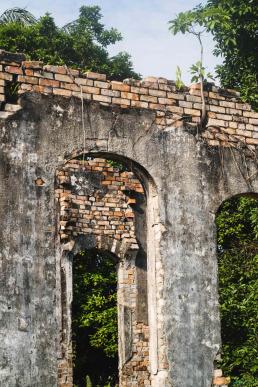
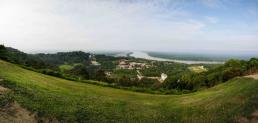
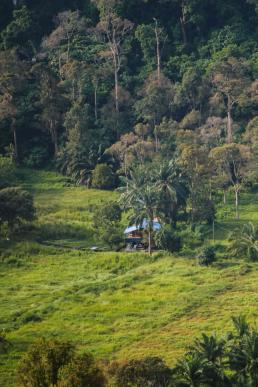
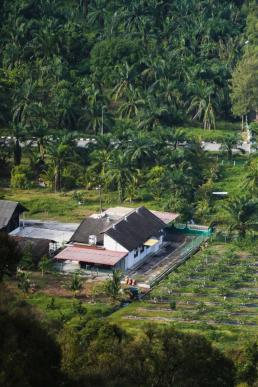
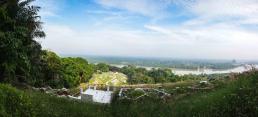
During the day, Bukit Jugra, depending on which side of the hill you were on, commanded a 360 degrees view of its surroundings. If one were on top of the lighthouse observatory, they would no doubt be able to see all. This morning, it was populated by triumphant joggers and cyclists, both who were rewarding themselves by resting on the hillside and enjoying the vista.
It wasn’t some time before we decided to take leave and head back. We drove back down slowly, and on the way, stopped by Istana Bandar Jugra. The palace grounds were closed today, so we were only able to admire from outside its gates. The palace apparently had been left vacant since the Malayan Independence and now only served as a historical site of sorts. And Jugra, being located in a remote corner of Selangor, spoke to its lack of acknowledgement in the narrative of modern Selangor, let alone Malaysia.
Many a century ago, Jugra was considered Selangor’s administrative centre and was even acknowledged as far back as during the rule of the Malaccan Sultanate. Hulu Langat in the early 1800s was known for its natural resources of tin and rattan. Even during British colonial administration, Jugra was still considered an important epicentre due to its strategic location.
It was after Port Swettenham, now Port Klang was established in 1987, did Jugra slowly lost its prominence. Not that it wasn’t already in slow decline. Almost a century prior in 1882, Selangor’s administrative had already shifted to Klang. The development of the industrial port city simply sealed its fate.
Now, Jugra plays a quiet role in the state’s narrative. The few who dig deeper would recognise its importance, while many now visit the place to enjoy an excursion by foot or bike. As I left Jugra, I felt a sense of history lost. And I wondered if those of the Selangor royal family ever feel the same if they think of their forefathers who once resided in this small part of the state.
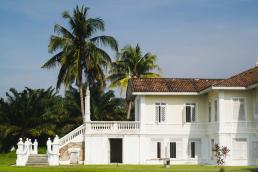
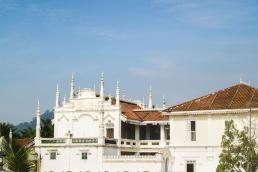
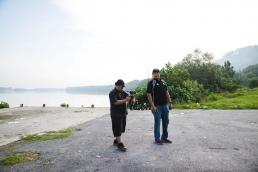
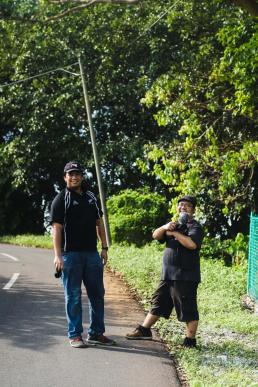
Asyraf’s vlog experience of Jugra on his YouTube channel: Jalan Lihat Dengar.